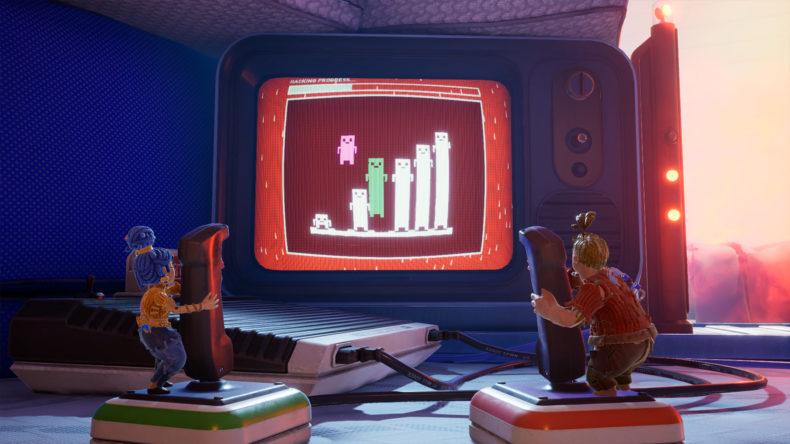I’m going to ask for your patience for a moment, here. I’ve worked in the industry for over a decade now, and I’ve interviewed and interacted with countless people who make games, and I’ve learned a lot in that time. When you’re starting out and given a fifteen minute slot, you panic and think that’s not enough time to ask all the burning questions you desperately want answers to. Ten years in, you realise fifteen minutes is too long.
It’s not that the people aren’t interesting, but they can’t answer most of the actually interesting things you have to ask. Either they’re not allowed, or are wary of things being taken out of context and used against them, and I understand that: a game is their baby, and marketing it is the equivalent of a social media post: best foot forward, hide the moments when things aren’t quite going their way. And I can count on two hands the number of times I’ve been in the presence of a member of a dev-team that haven’t felt like that.
Josef Fares is certainly on that list. He’s effusive about his games, and he’s either a marketing genius, or refreshingly candid. Or perhaps both? He says things I can imagine make his publisher’s collective asses clench. As he tells a digital room full of media and influencers about his studio’s (Hazelight) past and present, he explains how “then we started working with the publisher (EA), and it was cool… I know people like to talk shit, but it’s been cool”, and even that allusion to what other people have said about the enormous publisher suggests he’s willing to talk fairly openly, or at least more openly than others. He reminds me of Peter Molyneux, in that he sometimes writes cheques he can’t cash, but at the time he means it: this is his truth.

He’s relaxed and a bit thrown by the digital nature of the event: we can see him but he can’t see us. He jokes about how lucky his studio has been with It Takes Two, given that they had performance actors in right before the pandemic hit, and then they managed to finish work in the window when we weren’t all shut in, saying “Coronavirus ain’t got shit on Hazelight”. If anyone else said that, it’d be a headline on some website, and it probably still will, but I get the feeling he isn’t that fussed.
But if A Way Out was all about Fares, with his voice acting and motion capture, It Takes Two should be all about the team at Hazelight. A visually striking affair with some unique and phenomenal sound design, if A Way Out felt like a b-movie, It Takes Two is the big-budget game by way of Pixar visuals. It looks and sounds terrific, but crucially there’s more to it. A game can look great but be dull to play, and this is anything but that. The feel of the platforming and movement is tight as it comes, and Fares himself admits that he doesn’t know anything about coding, so while he’s an ideas man — an auteur if you will — the resulting game is down to the faceless talent behind the scenes making it look great, sound right, and feel incredible.
And Josef Fares is in his trademark buoyant mood. The only time he bristles slightly is when questioned about replayability, and it was here that I realised I’d probably get on with this man if we sat in the pub together. “Do you know many people don’t even finish games?”, he says, “Let’s just focus on making a game people actually get through!”. And this is clearly part of the marketing, with a trailer that explains how there’s no “shiny shit” to collect in It Takes Two (and there isn’t, that’s true). Ironically, it does have replayability. Playing as Cody or May, they end up with different abilities and ways to get through each section, and I’d love to play again to see some of the stuff my co-op partner, Chris, got up to as May.
He goes on to explain that the game is mechanically diverse, with new ideas thrown in at every turn. After playing through around two and a half hours with Chris White, I can attest to this being true. A throwaway comment during the presentation from Fares explained that his team could spend a year making a section and, whoosh, it’s gone in minutes, never to be seen again. The closest thing I can come up with as a comparison is how in Super Mario Odyssey you’ll inhabit an enemy in one kingdom only to never use it again, and having played It Takes Two, this is definitely true.
During the close of the slice we got to play, there’s a section where you have to work as a team to pilot a hang-glider. It’s a section that lasts perhaps 90 seconds, maybe less, and I get the feeling it’ll never reappear again. There are ideas here so creative and unique that myself and Chris would both explain “wow”. The combat is tight, the solutions to the light puzzles are clever and intuitive, and it’s funny, too. It’s also remarkably dark with some of its humour, and has some bizarre characters that feel alive in the world.

In truth I lost count of how many moments we experienced that could appear on our “best moment” list come the end of 2021. And yet, I can see some people having a bad time with It Takes Two. Fares was asked about the story, given that it’s about a divorcing couple being forced to reconnect, how it would work if people played with their non-gaming friends or if people didn’t have pals to play with given that it’s exclusively co-op, and he was honest here, too. He explained that you can play online with random people, but I won’t put words in his mouth here, instead I’ll say it for him: you absolutely shouldn’t. This is a true co-op experience, one that’s rewarding but that requires you to work together.
It Takes Two is a story about recapturing the love, and on the basis of what I played, the story has some way to go, but crucially, it feels like (whether by accident or on purpose) Hazelight has managed to tell a different story: about recapturing the love of why we play. Fun, excitement, adventure, tight controls and hook after hook; it’s a game that just feels brilliant. It’s the most Nintendo-like game I’ve played that isn’t by Nintendo, and I absolutely cannot wait to get back to playing the rest of this wonderful game.
Josef Fares once said that if people didn’t enjoy It Takes Two he’d give them a thousand dollars. Most developers would want to forget that comment, yet he brings it up himself, smiling as he does so. And you know what, I suspect come March 26th, his bank account is going to be just fine, because if the time I spent with it bears fruit for the rest of the experience (which he tells us is 12-14 hours in total), this will be one of the best games of 2021.





